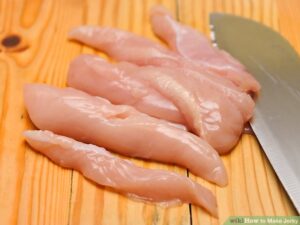I never liked beef jerky as bought from the corner stores. It was just to much *everything* to be any good to me. When I was a teenager, my dad made deer jerky with strips of marinated venison, and that was the first time I understood that jerky could be something other than that store-bought mess of ground meat. This jerky is plain and simple. I’ve taken some (for jerky) nonstandard liberties to improve the taste (to me). The same recipe is possible with boneless, skinless thighs instead of breasts, or with other poultry like turkey.
Ingredients:
- Organic chicken breast
- Sea salt
- Organic ground black pepper

Directions:
- Trim the chicken to remove any fatty bits. Fat can become rancid. Slice the chicken into 1/4″ thick pieces.
- Lay out the chicken pieces on a cutting board and dust with pepper and salt. Flip the pieces and do the same on the other side (if you don’t like much pepper, skip pepper on the second side). Remember that the flavour will be more concentrated when the meat is shrunken and dry than when it is moist. I like to put an even sprinkle all over, but this takes some finessing to meet your tastes.
- You need to get the chicken briefly up to 165 degrees Fahrenheit to kill any dangerous bacteria. This is best done while the chicken is moist, as heat will penetrate better. How you do this will depend on what appliances you have available to you. Note: Newer conventional ovens typically do not operate as low as 165 degrees. If this is the case for you, set the oven to its “Keep Warm” setting (typically 170 degrees Fahrenheit) and prop the oven door open slightly.
- If you are using a dehydrator that can go up to 165 degrees, place the strips directly into the dehydrator.
- If you are using a dehydrator that cannot go up to 165 degrees Fahrenheit, preheat your oven to 165 degrees Fahrenheit. Once the oven is warm, place the strips on a piece of parchment paper on a pan or on the rack. This is the least preferred option for contamination reasons.
- If you are using a countertop over with dehydrating abilities, place the strips on the rack in that, at the position suggested by the manufacturer.
- If you are using a conventional oven, preheat the oven to 165 degrees Fahrenheit. Once hot, place the strips very carefully over the rack.
 Heat the chicken strips for up to 15 minutes or until they reach 165 degrees Fahrenheit internal temperature. Watch carefully. If your chicken strips begin to change colour and become more white, they are beginning to cook and you need to stop.
Heat the chicken strips for up to 15 minutes or until they reach 165 degrees Fahrenheit internal temperature. Watch carefully. If your chicken strips begin to change colour and become more white, they are beginning to cook and you need to stop.- Lower the temperature of the meat.
- If your chicken strips are already in your dehydrator, lower the temperature to the temperature recommended by your dehydrator manufacturer for jerky making.
- If you need to move your jerky to the dehydrator, do so at this time. Use only clean utensils and try to avoid touching the jerky with your hands to avoid transferring bacteria to the chicken. Try to move quickly so that the chicken slices stay as close to 165 degrees as possible until they are sealed in the dehydrator.
- If you are using a countertop oven with dehydrating capabilities, lower the temperature of the oven to that recommended by the manufacturer for dehydrating jerky (120 to 125 degrees is typical for dehydrating vegetables, but is a bit low for meats). If they have not recommended a temperature, aim for 130 to 140 degrees Fahrenheit.
- If you are using a conventional oven, prop the door open more until the internal temperature rests closer to 130 to 140 degrees Fahrenheit.
- Leave the chicken strips to dehydrate for approximately 5 to 7 hours, or until the strips are a bit crunchy rather than chewy and bendy. You want as much water as possible out of the meat. Once dry and cool, you can try your jerky. If you are happy with your jerky at this stage, skip directly to step 8.
- Here’s my non-conventional step. I don’t like the taste of the raw jerky as much as I like it just a little bit cooked. Raise the temperature of the oven to 275 degrees Fahrenheit, or move the jerky to a preheated oven set to 275 degrees Fahrenheit. Allow to sit at that temperature until the colour begins to change towards a more reddish/orangeish colour. The goal isn’t to fully cook the jerky, just to toast it a bit. In a countertop oven, this can take just a little over 5 minutes.
- Allow the strips to cool, and place in a bag in the freezer to store. If you like, you can take the additional step of sealing with a vacuum sealer prior to freezing. The freezer will help make sure any bacteria that got on the meat are less likely to grow and multiply. You can store the jerky in the freezer for at least 1 to 2 months. Take the jerky out of the freezer just prior to eating. If you do not want to keep the jerky in the freezer, expect a shorter shelf life.
